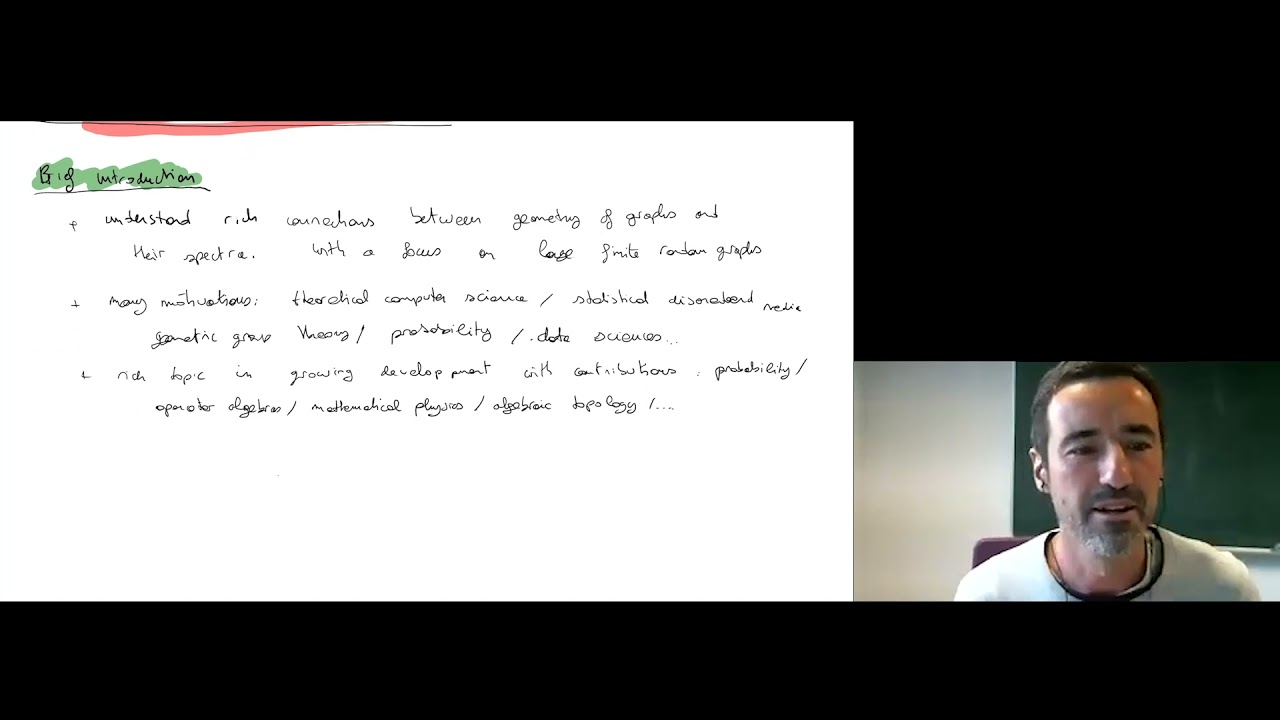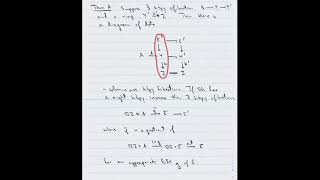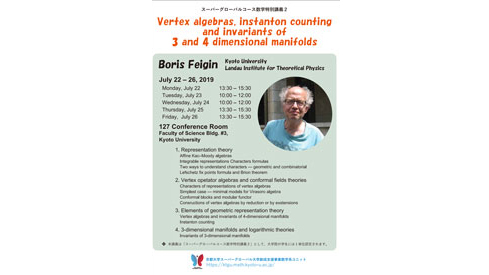SGU Mathematics Kickoff Meeting
Rational curves and symplectic manifolds Prof. Manfred Lehn
-

- Rational curves and symplectic manifolds
-
Prof. Manfred Lehn
Mar. 10, 2015 1:21:04 English
-

- The spaces Up and Vp and global solutions to dispersive equations
-
Prof. Herbert Koch
Mar. 10, 2015 1:07:31 English
-

- The topology of positive scalar curvature
-
Prof. Thomas Schick
Mar. 10, 2015 1:13:25 English
-

- Fundamental groups, reciprocity laws, and Diophantine equations
-
Prof. Minhyong Kim
Mar. 10, 2015 1:08:11 English
-

- Quantum expanders, random matrices and geometry of operator spaces
-
Prof. Gilles Pisier
Mar. 10, 2015 1:09:55 English
-

- Random polymers
-
Prof. Erwin Bolthausen
Mar. 10, 2015 1:14:47 English
Details
- Year/Term
- 2014
- Date
- March 9th to March 10th, 2015
- Faculty/
Graduate School - Graduate School of Science
- Language
- English
- Instructor name
- Manfred Lehn(Professor, Johannes Gutenberg-Universität Mainz)
Herbert Koch(Professor, Universität Bonn)
Thomas Schick(Professor, Georg-August-Universität Göttingen)
Minhyong Kim(Professor, University of Oxford)
Gilles Pisier(Distinguished Professor, Texas A&M University)
Erwin Bolthausen (Professor Emeriti, Universität Zürich)
- Place
- Room 127, Graduate School of Science Bldg No 3
1. March 9, 2015 14:40-15:40 Rational curves and symplectic manifolds
Manfred Lehn (Johannes Gutenberg-Universität Mainz / Professor) Video
Abstract
A symplectic manifold in the context of this talk is a compact complex manifold with the additional structure that each tangent space is equipped with a skew-symmetric bilinear form which, when expressed in terms of local coordinates, varies holomorphically. Whereas there are plenty of examples for the real version of this notion, compact complex symplectic manifolds are rather dicult to construct. A famous and by now classical paper of Mukai shows how such manifolds can be obtained as moduli spaces of vector bundles on a certain complex surface. The key insight is that geometric properties of a point in such a parameter space can be intrinsically expressed in terms of the properties of the object that the point represents. Taking this idea further we consider moduli spaces (=parameter spaces) of rational curves that lie on a four dimensional hypersurface of degree 3 and show how new symplectic manifolds can be obtained from these by a contraction process. This relates to work of Kuznetsov on the derived category of cubic fourfolds and connects with another strand of Mukai’s early paper. In the talk I want to give an introduction to this circle of ideas and present some recent developments.
2. March 9, 2015 16:10-17:10 The spaces Up and Vp and global solutions to dispersive equations
Herbert Koch (Universität Bonn / Professor) Video
Abstract
Functions of finite p variation occur at various places in mathematics: Dispersive equations, harmonic analysis, and the rough path theory in probability. I will explain their definition and properties, the relation to Strichartz estimates and bilinear estimates, and the application to several dispersive equations.
3. March 10, 2015 10:00-11:00 The topology of positive scalar curvature
Thomas Schick (Georg-August-Universität Göttingen / Professor) Video
Abstract
Given a smooth compact manifold M without boundary, does it admit a Riemannian metric with posi- tive scalar curvature everywhere? This question reveals deep connections between geometry, topology, and analysis (through the modern method to answer it). The most classical answer is given for 2-dimensional surfaces by the Gauss-Bonnet theorem: if a manifold has positive curvature then its Euler characteristic is positive. In higher dimensions, the role of the Euler characteristic is taken by the index of the Dirac operator. To make ecient use of this, recent developments of operator algebras have to be used. The talk will mainly try to introduce the basics of these exciting methods, and explain in examples how it works.
4. March 10, 2015 11:20-12:20 Fundamental groups, reciprocity laws, and Diophantine equations
Minhyong Kim (University of Oxford / Professor) Video
Abstract
In the late 19th century, Kurt Hensel introduced non-Archimedean completions of algebraic number fields, which was used soon afterwards by Minkowski and Hasse to study Diophantine equations via the so- called local-to-global principles. During the first world war, Takagi proved the existence theorem for class fields, leading up to his lecture at the ICM in Strasbourg, and laid the foundation for Artin’s reciprocity law of class field theory. In this lecture, we will remark briefly on subsequent developments, concluding with a description of recent attempts to refine Hasse principles using arithmetic fundamental groups and non-abelian reciprocity laws.
5. March 10, 2015 14:00-15:00 Quantum expanders, random matrices and geometry of operator spaces
Gilles Pisier (Texas A&M University / Distinguished Professor) Video
Abstract
Using random unitary matrices, we show that there are well separated families of quantum expanders with asymptotically the maximal cardinality allowed by a known upper bound. This has applications of “geometric” nature, for the operator space analogue of Euclidean geometry. This allows us to provide sharp estimates for the growth of the multiplicity of MN-spaces needed to represent (up to a constant C > 1) the MN -version of the n-dimensional operator Hilbert space OHn as a direct sum of copies of MN. We show that, when C is close to 1, this multiplicity grows as expβnN2 for some constant β > 0. The main idea is to identify quantum expanders with “smooth” points on the matricial analogue of the unit sphere, and to show that there are plenty of “uniformly smooth” points (more precisely as many as allowed by a soft metric entropy dimensional restriction). This generalizes to operator spaces a classical geometric result on n-dimensional Hilbert space (corresponding to N = 1). Our work strongly suggests to further study a certain class of operator spaces that we call matricially subGaussian.
(About the formula, please refer to https://www.math.kyoto-u.ac.jp/sites/default/files/public_files/SGUKick_0.pdf.)
6. March 10, 2015 15:30-16:30 Random polymers
Erwin Bolthausen (Universität Zürich / Professors Emeriti) Video
Abstract
A (directed) random polymer in d + 1 dimensions is a (standard) random walk in d dimensions where the time axis is considered as an additional dimension, which is transformed by a random potential in space and time. The best known and most famous case is the directed polymer in random environment which has a potential given by independent random variables in space and time. Some of the basic questions are open even in 1 + 1 dimensions which is believed to be connected with the KPZ universality class. The only case of the 1 + 1 dimensional directed polymer which has been fully analyzed is a very special one investigated by Kurt Johannson. Important partial results on the directed polymers have been obtained by Imbrie-Spencer, Bolthausen, Comets-Shiga-Yoshida, Carmona, Petermann, and many others.
The main focus of the talk will however be on the so-called copolymer, first discussed in the physics literature by Garel, Huse, Leibler and Orland in 1989 which models the behavior of a polymer at an interface. Important rigorous results have first been obtained by Sinai and Bolthausen-den Hollander, and have later further been developed by Bodineau, Giacomin, Caravenna and others. A basic object of interest is a critical line in the parameter space which separates a localized phase from a delocalized one. Particularly interesting is the behavior at the weak disorder limit where the phase transition is characterized by a universal critical tangent whose existence had first been proved in the Bolthausen-den Hollander paper, and whose exact value is still open. In a recent paper by Bolthausen-den Hollander-Opoku, a new lower bound has been derived, disproving a long-standing conjecture from the physics literature. The bound was obtained by an application of a sophisticated large deviation theory developed by Birkner-Greven-den Hollander. We present a sketch of an elementary version of this new bound.
Related Courses
 Course
Course
Masae Ishihara, Yasuyuki Shibata
Graduate School of Science, Field Science Education and Research Center
2021 Course
Course
Prof. Charles Bordenave
Graduate School of Science
2021 Course
Course
Stephen Theriault
Graduate School of Science
2021 Course
Course
Boris FEIGIN
Graduate School of Science
2019
